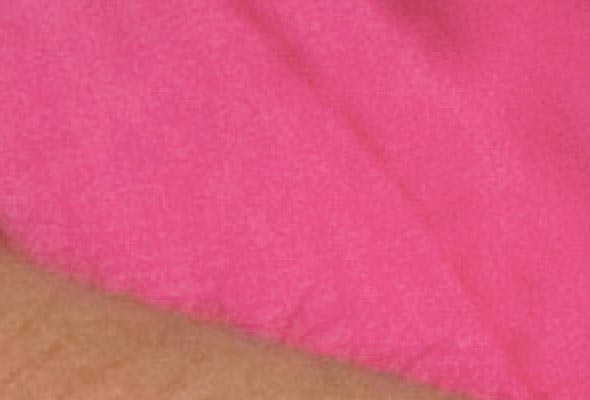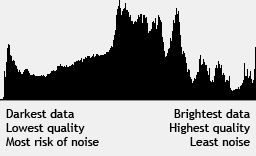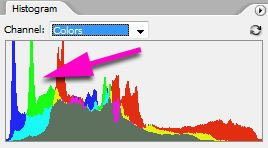Pesky pinks
Rowena sent me a photograph that was troubling her. In it, her daughter’s pink shirt appeared quite blotchy and pixelated when viewed at 100%, despite the fact that all the other detail in the image was perfectly normal, and despite the fact that she’d got good exposure at only ISO250, which is a piece of cake for her 5D.
I know this is a problem for everyone from time to time (although not everyone examines their photos as closely as Rowena!), so she cautiously gave me permission to use the photo here. Thanks, Ro!
Here’s the shot:

And here’s a close-up of the blotchiness at 200%. (Unfortunately the website compression has mangled it a bit, but I hope you can see it ok.)

To find the reason for this we must go back to one of the fundamental characteristics (flaws) of digital photography – data at the right-hand end of the histogram is much better quality than data at the left-hand end.

I’m sure you’re all aware of the "Expose to the Right" principle when shooting. The brighter the exposure you achieve in your images, the further the histogram data will reach to the right-hand end, and the better the pixel quality will be. Even low-end DSLRs can perform adequately at high ISOs if you get good exposure; but underexposure results in awful awful AWFUL noise.
Perhaps you’re wondering where I’m going with this. After all, Rowena’s daughter’s shirt isn’t dark – it’s quite bright pink.
But here’s the sting. Pinks (magentas, actually) exist at the left-hand end of the histogram. The brighter the pink, the further left it can be.
How can this be? Well, your camera captures in RGB mode, right? It captures shades of Red, Green and Blue. The other three "primary" colours – Cyan, Magenta and Yellow – are the spectral opposites of Red, Green and Blue. Pink’s (magenta’s) opposite colour is Green. From the camera’s point of view, Rowena’s daughter’s shirt isn’t full of magenta – it’s empty of green.
Here’s the colour histogram of Rowena’s photo. See that green mass toward the left end? That’s the pink shirt:

So, this is the paradox. Despite the brightness of the pink shirt, it’s actually being captured by the camera’s noisiest data. And that’s what Rowena has encountered.
Does this happen in other colours? Yes, indeed. Cyan colours are contained in the dark end of the Red channel, so you might see unexplained noise in nice skies. And yellows exist at the dark end of the Blue channel, which is actually the worst for noise, but luckily yellows are the least visible colour, so the problem is rarely evident.
What's the solution?
What can Rowena do about this problem? Well, obviously lower ISO would help, but only if it wasn’t at the expense of exposure. In truth, I don’t think it would make a whole lot of difference.
In Photoshop, the simplest measure would be to duplicate the Background layer and run noise reduction in the Filter menu, then mask that layer to the problem areas only.
